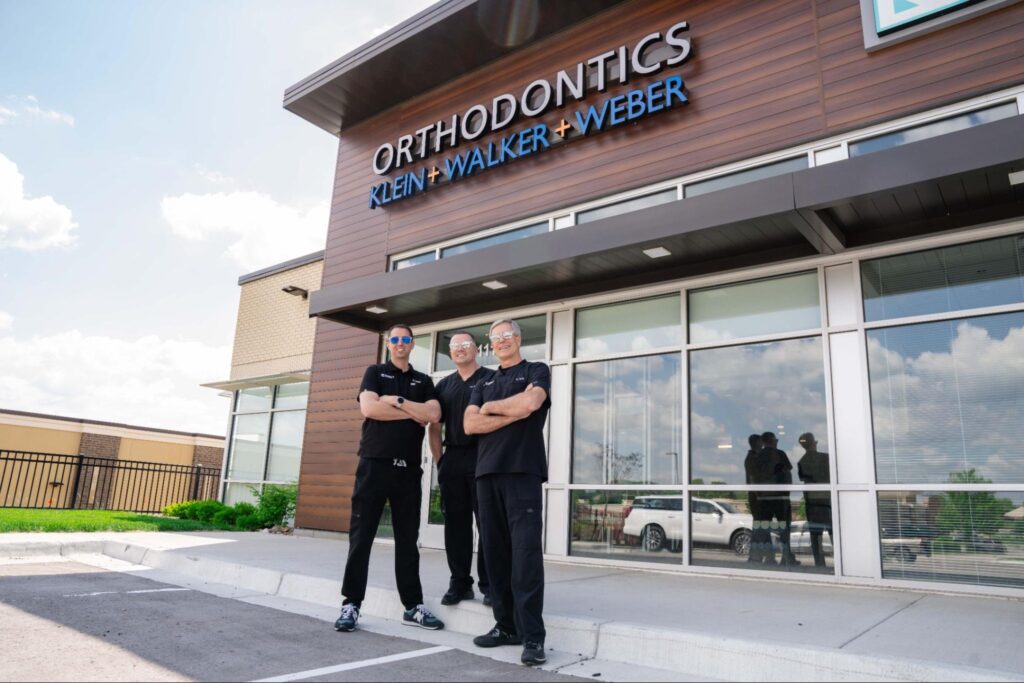Great orthodontics starts with a clear picture of what’s happening beneath the surface. Traditional two-dimensional X-rays are helpful, but they compress complex anatomy into flat images. 3D imaging (CBCT) gives Dr. Klein, Dr. Walker, and Dr. Weber a volumetric view so teeth, roots, bone, and airways can be evaluated in all three planes of space. That means your exam isn’t just a snapshot, it’s more like a map. With three-dimensional data, the team can see where erupting teeth really are, how close they sit to neighboring roots, and whether there’s enough bone to move teeth safely and predictably.
This extra information is especially valuable when a tooth takes an unusual path, or when crowding and growth patterns make “wait and see” a riskier strategy. Used thoughtfully and only when indicated, 3D imaging helps your doctors reduce uncertainty, avoid surprises, and plan treatment that respects both biology and your long-term smile.
Seeing More, Sooner: Early Detection of Ectopic Eruption
Ectopic eruption happens when a permanent tooth deviates from its normal path. That can lead to problems like a first molar resorbing the baby molar’s roots as it erupts, or a maxillary canine drifting toward the lateral incisor roots. The earlier these patterns are identified, the simpler the solutions usually are. 3D imaging can reveal the exact position and angulation of ectopic teeth and, critically, whether neighboring roots are at risk; these are details that are often hard to judge on 2D films alone. Peer-reviewed work shows 3D scans detect root resorption and the spatial relationship of ectopic canines to incisors more reliably than panoramic images, allowing safer, more targeted interception.
The American Association of Orthodontists recommends every child see an orthodontic specialist by age 7. That timing coincides with the eruption of first molars and incisors, the moment when ectopic patterns become visible and interceptive options are most effective. Early screening doesn’t mean early braces; it means smart monitoring and timely, lightweight intervention when it truly helps.
First Permanent Molars: Catching Problems Before They Snowball
When a first molar erupts on a collision course with the baby molar, it can get “hung up,” resorb roots, or drift forward. On a 3D scan, your doctor can see whether the eruption path is likely to self-correct or needs help, and exactly how much. That clarity guides conservative steps like separators, distalizing springs, or simple appliance tweaks, before a minor issue becomes a major space problem. Early identification and correction, such as that we sometimes perform during phase 1 treatment, can reduce downstream crowding and the need for more complex mechanics later.
Maxillary Canines: Protecting Lateral Incisor Roots
Impacted or ectopic canines are common and notoriously tricky on 2D films. With 3D data, the team can judge the canine’s position relative to neighboring roots, evaluate available space, and choose the least invasive path forward, which means anything from targeted space creation and extraction of a retained baby canine to guided eruption. Studies report better detection of incisor root resorption and more accurate localization with CBCT, informing safer decisions about timing and mechanics.
Planning With Precision: From Screening to a Safer, Simpler Plan
3D imaging makes a world of difference when it comes to improving your experience with orthodontic treatment. For growing patients in Overland Park, Olathe, and West Olathe, three-dimensional information helps your orthodontist decide if and when to intervene. Sometimes the best plan is watchful waiting with growth on your side; other times, a small interceptive step today prevents a larger corrective step tomorrow. For teens and adults, 3D data supports precise bracket positioning or aligner staging, clearer assessments of bone support, and better collaboration with your general dentist or oral surgeon when exposure-and-guidance or extractions are on the table.
Because the image shows roots, bone thickness, and the real location of unerupted teeth, your doctor can simulate movements and map forces with greater confidence. That usually translates into fewer surprises at appointments and a smoother overall experience.
Comfort, Safety & Dose: CBCT When It’s Worth It
Radiation safety matters, especially with kids. The guiding principle is ALARA (as low as reasonably achievable). At Klein & Walker Orthodontics, 3D imaging is used selectively, reserved for cases where the additional information affects diagnosis or changes the plan, like suspected ectopic eruption, impacted canines, unusual root anatomy, or surgical considerations. The benefit must outweigh the exposure, and the scan field of view and settings are chosen to fit the clinical question. That balance lets your family get the clarity you need without unnecessary imaging.
Everyday Wins, You’ll Notice
Families tend to feel the impact of 3D diagnostics in very practical ways. Appointments are more purposeful because the road map is clearer. Decisions about extracting a baby canine, creating space, or monitoring a molar are made with more certainty. If a surgical exposure is needed, the exact position and angulation are known ahead of time, so procedures are shorter and the orthodontic part can be planned to guide the tooth efficiently. Hygiene coaching can even be personalized when bone contours and root shapes are visible – one more way data turns into comfort and confidence.
For Growing Smiles in Overland Park, Olathe & West Olathe
Growth gives orthodontists powerful leverage; 3D imaging helps them use it wisely. In a single view, your doctor can assess airway size, dental development, and jaw relationships alongside eruption paths. If everything looks on track, great! That means you get the peace of mind that comes with a clean bill of health. If an ectopic pattern is brewing, small steps timed to growth can redirect eruption and lower the chances of impaction, root resorption, and crowding that’s harder to solve later. That’s the heart of early evaluation by age 7: not “brace them early,” but know early so you can act at the right moment.
FAQs: Straight Answers About 3D Orthodontic Imaging
Will my child always need a 3D scan?
No. Most routine exams rely on traditional imaging. A CBCT is considered when 3D information would change the diagnosis or plan. Common examples include suspected ectopic eruption, impacted teeth, and certain surgical or airway evaluations.
Is 3D imaging safe for kids?
When medically justified and captured with a child-sized field of view and settings, the diagnostic benefit outweighs the small dose. Your orthodontist will review the rationale before any scan.
How does 3D help with aligners or braces?
It clarifies root positions and bone support, which means tooth movements can be staged more predictably and forces can be planned with fewer compromises.
Start With a Free Consultation
Want to know if 3D imaging could simplify your child’s treatment or clarify your own options? Schedule a free consultation with Klein & Walker Orthodontics at our Overland Park, Olathe, or West Olathe office. We will review your goals, evaluate growth and eruption patterns, and explain when 3D imaging adds value. From there, you will leave with a clear diagnosis and a plan that fits your timeline and comfort.






